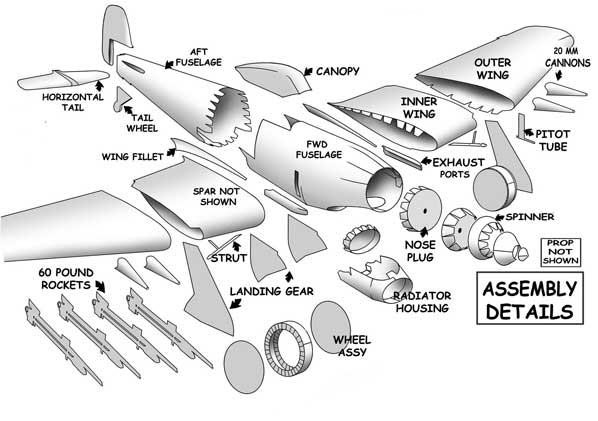

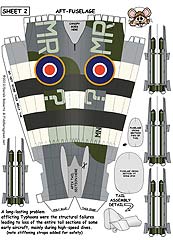
Hawker Typhoon - $$8.95
An interceptor that failed, the Hawker Typhoon was nearly canceled before it blossomed in the finest close support aircraft of World War II. With its pugnacious snub nose, four long-barreled cannon and whining Sabre engine, the big fighter-bomber wreaked havoc on its foes. Ranging far and wide over the battlefields of northwest Europe, swarms of Typhoons made an indelible mark on the history of warfare. Comes in Camo & BW plus two sizes
Hawker Typhoon

An interceptor that failed, the Hawker Typhoon was nearly canceled before it blossomed in the finest close support aircraft of World War II. With its pugnacious snub nose, four long-barre led cannon and whining Sabre engine, the big fighter-bomber wreaked havoc on its foes. Ranging far and wide over the battlefields of northwest Europe, swarms of Typhoons made an indelible mark on the history of warfare.
 |
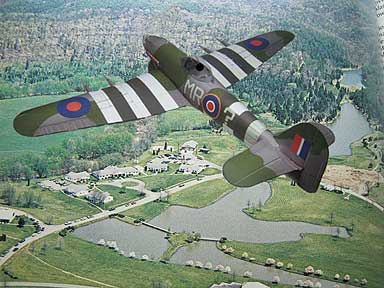 |
Thanks to Bob Martin for his Typhoon models |
|
Just a heads up: the Typhoon sheets state that the bubble-canopied models had 4-bladed props. Though it was a popular and desirable idea, only a fraction of late late-model Tiffys ever actually got them (somewhere in the 25-30% range).
Also, for some reason or other the last page of the regular version (wing center sections) is all screwy with scaling and comes out way too big. It's easy to fix when printing, but I know some people are unfamiliar with how to do so. Thanks for keeping all the great stuff coming! I look forward to seeing what comes next :) -Elliot
What People Say:Hey Chip, the emails you post on the model pages always seem to make me smile, so I thought I'd contribute one of my own.
I just finished the new Tiffy and I'll be darned if it's not just one of the greatest kits ever to come from FG! The graphics are phenomenal (the navigation light detail was a really nice touch), the 'chin' looks perfect, and, above all, the whole kit has been designed with the builder in mind. From the narrowing of the upper cowling to the join at the bottom of the rudder that ensures a clean curve, not to mention the slits at the wingtips that give them their perfect form, this model falls together brilliantly. Perhaps the best part is the way the otherwise-tricky wings come together: the way the tabs are laid out makes it impossible to mess up! And don't even get me started on the chin...
Overall, though a tad bit more complex than some of FG's other offerings, this has to be by far one of your best looking and easiest to build kits yet. I can't wait to see what else you've got up your sleeve!Thanking (and congratulating) you for another great model, Elliot :)
Hawker Typhoon

Designed as an interceptor,
the Hawker Typhoon was
plagued by numerous problems, which almost led to its
cancellation. It was to emerge however, as
the RAF's most important close support aircraft of the war. The
Typhoon's origins date to a 1938 Air
Ministry request for a  heavily-armed
single-seat fighter an craft capable of
400 mph. Hawker's chief designer
Hurricane enter production and in
1937 had started work on a new
design anticipating the Air Ministry
requirement.
heavily-armed
single-seat fighter an craft capable of
400 mph. Hawker's chief designer
Hurricane enter production and in
1937 had started work on a new
design anticipating the Air Ministry
requirement.
The new fighter was to be armed with four 20-mm cannon and would be tested with two engines: the Vulture. The air-cooled Bristol Centaurus was overlooked due to the official distrust of this type of powerplant, a decision that would later be regretted. Named Tornado the Vulture-powered version showed much promise but Rolls-Royce's decision to abandon the project to concentrate on Merlin production left the way clear for the Sabre-powerd typhoon.
With Hawker factories running to capacity production was initiated by Gloster factory at Hucclecote and the first production example flew from here on 27 May 1941. Trials carried out shortly afterwards were to prove to be extremely disappointing. The Napier engine was extremely unreliable, often failing in flight and requiring major overhaul every 25 hours. Performance and climb rate were also well below expectations especially at altitude where most of the dogfights were likely to occur. Problems in production of the intended cannon armament resulted in many of the first production Typhoons being fitted with an eight-machine gun wing as the Mk IA before production finally centered on the cannon armed Mk IB. No 56 Squadron received its first Typhoons in September 1941 with No 266 Squadron following on in February; however, by now an even more serious problem had been identified. Elevator flutter at low speeds was leading to structural failure of the tail assembly and many Typhoons were lost during the first half of 1942. The two operational squadrons were achieving little success in the interception role and there was a growing feeling within the Air Ministry that the Typhoon should be cancelled.

The turning point in the Typhoon's career came in the autumn of 1942 when feelings against the Typhoon were running at their highest. Squadron Leader Roland Beaumont requested to transfer his unit, No 609 Squadron, to Manston to support Hurricane and Spitfire Rhubarb ground-attack missions against targets in the Low Countries. In the next five months the squadron destroyed over 100 locomotives and numerous other ground targets as well as 14 Focke-Wulf FW 190s in low-level combat. No 609 Sqn's efforts combined with the much-needed cure for the structural problems secured the Typhoon's future in a new role.
The addition of bomb racks and rocket projectiles beneath the wing, tested in the spring of 1943 turned the Typhoon into a formidable attack aircraft. As more bomb- and rocket- equipped versions reached an increasing number of RAF squadrons, the attacks on targets of opportunity such as trains and convoys, pioneered by No 609 Sqn, increased in frequency. Typhoons also made a valuable contribution to the Channel Stop operations, firing salvos of rockets against German shipping in the English Channel. Eventuality, 26 squadrons flew the Typhoon and many of these were involved in attacking German radar stations and lines of communication throughout northern France in preparation for D-Day.
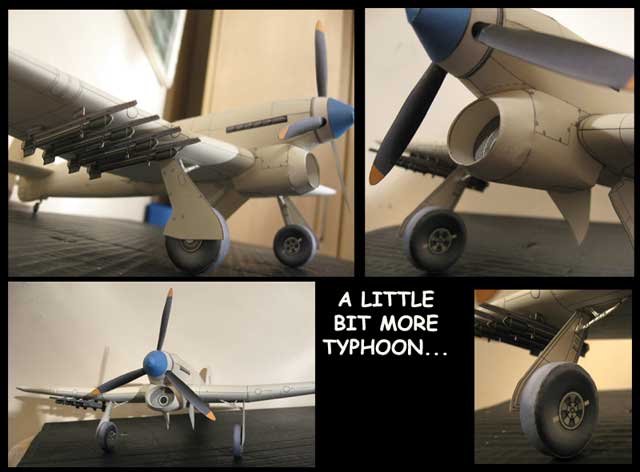 These are photos of Derek Robert's(the designer) Hawker Typhoon cardmodel |
|
Following the D-Day invasion
2nd Tactical Air Force Typhoons
played a vital role in the Allies breakout
from the beachheads.
With air
superiority assured the Typhoons
destroyed columns of troops,
artillery, tanks and machinery at will,
causing monumental damage to the
German defenses. The 'cab rank' system of
standing patrols was established
as the Allies advanced, allowing
specific targets to be destroyed
on request, at short notice by army
units. Rocket-equipped Typhoons of
the 2nd TAF continued to wreak
havoc on ground targets throughout
1945 . However, after VE-Day having
played such a vital role in the Allies
victory, the Typhoons were rapidly
withdrawn from service and reduced
to scrap.
 Armed Hawker Typhoon. |
|
 Cockpit of the Hawker Typhoon.
|
|
 Besides being a world class designer, Fiddlersgreen's Derek Roberts is a great builder as this Hawker Typhoon proves |
 View of the Hawker Typhoon's bottom- Derek's cardmodel |
Specifications for the Hawker Typhoon
 |
Length: 31 ft 11.5 in |
 |
||
| A: Originally carrying 12 Browning 7.7-mm machine guns, the Typhoon was soon to be equipped as standard with four harder-hitting 20-mm Hispano cannon and eight 60-lb. rockets. | B: All Allied aircraft were painted with large "invasion stripes" just before the invasion of France in June 1944. Invasio n Stripes were 132" wide | C: Typhoon pilots were well protected, with a bulletproof canopy, a huge engine in front of them and superb armor plate behind. |
 |
|||
| A: The Typhoon was much improved as a combat aircraft when a sliding bubble canopy was installed. | B: The Napier Sabre was a hugely powerful engine, but initially suffered from chronic problems, with engine life as low as 20 hours. | C: The Typhoon wing was a solidly built structure, allowing the aircraft to carry large bombs and to make power dives at almost 496 m.p.h. | D: The early tail problems of the Typhoon were cured by the fitting of "fish plates" to strengthen the structure. |
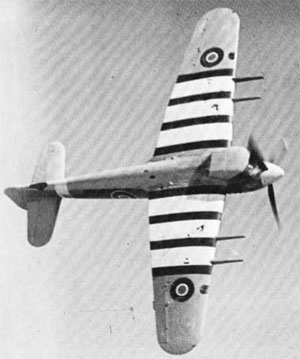
 |
Burned out and damaged Typhoons on the field. 19 were lost when the Luftwaffe attacked this field. |

 |
This Typhoon cutaway comes in full size 8.5x11 PDF for FREE included when you buy the Typhoon model |



